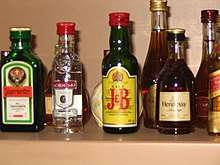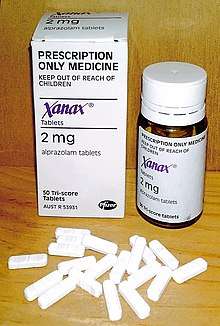Depressant
A depressant, or central depressant, is a drug that lowers neurotransmission levels, which is to depress or reduce arousal or stimulation, in various areas of the brain.[1] Depressants are also occasionally referred to as "downers" as they lower the level of arousal when taken. Stimulants or "uppers" increase mental and/or physical function, hence the opposite drug class of depressants is stimulants, not antidepressants.
Depressants are widely used throughout the world as prescription medicines and as illicit substances. Alcohol is a very prominent depressant. Alcohol can be and is more likely to be a large problem among teenagers and young adults. When depressants are used, effects often include ataxia, anxiolysis, pain relief, sedation or somnolence, and cognitive/memory impairment, as well as in some instances euphoria, dissociation, muscle relaxation, lowered blood pressure or heart rate, respiratory depression, and anticonvulsant effects, and even similar effects of General Anaesthesia and/or death at high doses. Cannabis may sometimes be considered a depressant. THC may slow brain function to a small degree, while reducing reaction to stimuli. Cannabis may also treat insomnia, anxiety and muscle spasms similar to other depressive drugs. Other depressants can include drugs like Xanax (a benzodiazepine) and a number of opiates.
Depressants exert their effects through a number of different pharmacological mechanisms, the most prominent of which include facilitation of GABA, and inhibition of glutamatergic or monoaminergic activity. Other examples are chemicals that modify the electrical signaling inside the body, the most prominent of these being bromides and channel blockers.
Indications
Depressants are used medicinally to relieve the following symptoms:
Types
Alcohol

An alcoholic beverage is a drink that contains alcohol (also known formally as ethanol), an anesthetic that has been used as a psychoactive drug for several millennia. Ethanol is the oldest recreational drug still used by humans. Ethanol can cause alcohol intoxication when consumed. Alcoholic beverages are divided into three general classes for taxation and regulation of production: beers, wines, and spirits (distilled beverages). They are legally consumed in most countries around the world. More than 100 countries have laws regulating their production, sale, and consumption.[2]
The most common way to measure intoxication for legal or medical purposes is through blood alcohol content (also called blood alcohol concentration or blood alcohol level). It is usually expressed as a percentage of alcohol in the blood in units of mass of alcohol per volume of blood, or mass of alcohol per mass of blood, depending on the country. For instance, in North America a blood alcohol content of "0.10" or more correctly 0.10 g/dL means that there are 0.10 g of alcohol for every dL of blood (i.e., mass per volume is used there).[3]
Barbiturates
Barbiturates are effective in relieving the conditions that they are designed to address (insomnia, seizures). They are also commonly used for unapproved purposes, are physically addictive, and have serious potential for overdose. In the late 1950s, when many thought that the social cost of barbiturates was beginning to outweigh the medical benefits, a serious search began for a replacement drug. Most people still using barbiturates today do so in the prevention of seizures or in mild form for relief from the symptoms of migraines.
Benzodiazepines

A benzodiazepine (sometimes colloquially "benzo"; often abbreviated "BZD") is a drug whose core chemical structure is the fusion of a benzene ring and a diazepine ring. The first such drug, chlordiazepoxide (Librium), was discovered accidentally by Leo Sternbach in 1955, and made available in 1960 by Hoffmann–La Roche, which has also marketed the benzodiazepine diazepam (Valium) since 1963.
Benzodiazepines enhance the effect of the neurotransmitter gamma-aminobutyric acid (GABA) at the GABAA receptor, resulting in sedative, hypnotic (sleep-inducing), anxiolytic (anti-anxiety), anticonvulsant, and muscle relaxant properties; also seen in the applied pharmacology of high doses of many shorter-acting benzodiazepines are amnesic-dissociative actions. These properties make benzodiazepines useful in treating anxiety, insomnia, agitation, seizures, muscle spasms, alcohol withdrawal and as a premedication for medical or dental procedures. Benzodiazepines are categorized as either short-, intermediate-, or long-acting. Short- and intermediate-acting benzodiazepines are preferred for the treatment of insomnia; longer-acting benzodiazepines are recommended for the treatment of anxiety.
In general, benzodiazepines are safe and effective in the short term, although cognitive impairments and paradoxical effects such as aggression or behavioral disinhibition occasionally occur. A minority react reverse and contrary to what would normally be expected. For example, a state of panic may worsen considerably following intake of a benzodiazepine. Long-term use is controversial due to concerns about adverse psychological and physical effects, increased questioning of effectiveness, and, because benzodiazepines are prone to cause tolerance, physical dependence, and, upon cessation of use after long-term use, a withdrawal syndrome. Due to adverse effects associated with the long-term use of benzodiazepines, withdrawal from benzodiazepines, in general, leads to improved physical and mental health. The elderly are at an increased risk of suffering from both short- and long-term adverse effects.
There is controversy concerning the safety of benzodiazepines in pregnancy. While they are not major teratogens, uncertainty remains as to whether they cause cleft palate in a small number of babies and whether neurobehavioural effects occur as a result of prenatal exposure; they are known to cause withdrawal symptoms in the newborn. Benzodiazepines can be taken in overdoses and can cause dangerous deep unconsciousness. However, they are much less toxic than their predecessors, the barbiturates, and death rarely results when a benzodiazepine is the only drug taken; however, when combined with other central nervous system depressants such as alcohol and opiates, the potential for toxicity and fatal overdose increases. Benzodiazepines are commonly misused and taken in combination with other drugs of abuse. In addition, all benzodiazepines are listed in Beers List, which is significant in clinical practice.
Cannabis
Cannabis is often considered either in its own unique category or as a mild psychedelic.[4][5] The chemical compound tetrahydrocannabinol (THC), which is found in cannabis, has many depressant effects such as muscle relaxation, sedation, decreased alertness, and less tiredness. Contrary to the previous statement, activation of the CB1 receptor by cannabinoids causes an inhibition of GABA, the exact opposite of what central nervous system depressants do.[6]
Opioids
Contrary to popular misconception, opioids are not depressants in the classical sense.[4] They do produce central nervous system depression, however, they also excite certain areas of the central nervous system. To remain true to the term 'depressant' – opioids cannot be classified as such. For opioid agonists and opium derivatives, these are classified differently. Analgesic or narcotic correctly identifies these drugs. However, they do have depressant actions nonetheless.
Miscellaneous
- Alpha and beta blockers (Carvedilol, Propranolol, atenolol, etc.)
- Anticholinergics (Atropine, hyoscyamine, scopolamine, etc.)
- Anticonvulsants (Topiramate, carbamazepine, lamotrigine, etc.)
- Antihistamines (Diphenhydramine, doxylamine, promethazine, etc.)
- Antipsychotics (Haloperidol, chlorpromazine, clozapine, etc.)
- Hypnotics (Zolpidem, zopiclone, chloral hydrate, eszopiclone, etc.)
- Muscle relaxants (Baclofen, phenibut, carisoprodol, cyclobenzaprine, etc.)
- Sedatives (Gamma-hydroxybutyrate, etc.)
Methods of intake
Combining multiple depressants can be very dangerous because the central nervous system's depressive properties have been proposed to increase exponentially instead of linearly. This characteristic makes depressants a common choice for deliberate overdoses in the case of suicide. The use of alcohol or benzodiazepines along with the usual dose of heroin is often the cause of overdose deaths in opiate addicts.
References
- "Depressant - Definition". Princeton WordNet. Retrieved 28 December 2013.
- "Minimum Legal Age Limits". IARD.org. International Alliance for Responsible Drinking. Archived from the original on 4 May 2016. Retrieved 23 June 2016.
- Ethanol Level at eMedicine
- World Health Organization (August 31, 2009). Clinical Guidelines for Withdrawal Management and Treatment of Drug Dependence in Closed Settings (PDF). p. 3. ISBN 978-92-9061-430-2.
Cannabis is a depressant drug, but it also has hallucinogenic effects.
- Amsterdam, Jan; Nutt, David; Brink, Wim (January 23, 2013). "Generic legislation of new psychoactive drugs" (pdf). J Psychopharmacol. 27 (3): 317–324. doi:10.1177/0269881112474525. PMID 23343598.
Figure 1
- Hájos, N.; Katona, I.; Naiem, S. S.; Mackie, K.; Ledent, C.; Mody, I.; Freund, T. F. (2000). "Cannabinoids inhibit hippocampal GABAergic transmission and network oscillations". European Journal of Neuroscience. 12 (9): 3239–3249. doi:10.1046/j.1460-9568.2000.00217.x. PMID 10998107.
External links
- Painfully Obvious - A Community Resource
- Fact sheets and Harm Reduction Strategies About Depressants and Other Recreational Drugs
- U.S. Department of Human and Health Services: Drug Categories for Substances of Abuse
- About Psychotropic Medications: Quick Reference to Medications Used in Mental Health
- National Institute on Drug Abuse: "NIDA for Teens: Prescription Depressant Medications".